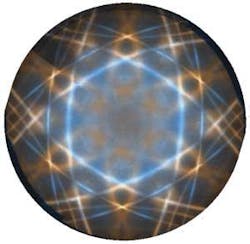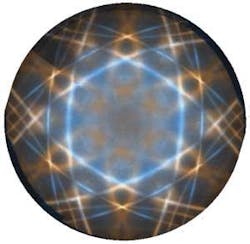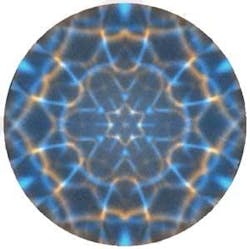LIGHT-EMITTING DIODES: Photonic-crystal LED has high extraction efficiency

In a step toward reaching the ultimate light-extraction efficiency for high-power, high-brightness LEDs, researchers at Philips Lumileds Lighting (San Jose, CA) and Philips Research (Eindhoven, The Netherlands) have created a blue-emitting LED that uses a photonic-crystal (PC) structure to reach an estimated unencapsulated light-extraction efficiency of 73%.1
The fact that this efficiency was reached for an unencapsulated LED is important for two reasons. First the organic materials used for LED encapsulants degrade under high intensities, and are thus unsuitable for the highest-power LEDs. Second, the use of an encapsulant decreases the brightness of an LED; this happens because the encapsulant, which has a higher refractive index than air, is in direct contact with the LED emitter—which means that light rays escape from the emitter into the encapsulant at a higher angle than if there were an air gap, increasing the “optical size” of the LED. (For a typical encapsulated LED, the brightness is decreased by about a factor of two.)
Getting the light out
Light formed within a typical planar-slab LED at an angle less than the critical angle gets refracted out into the world, while light formed at an angle greater than the critical angle gets trapped inside the LED by total internal reflection. The trapped light propagates within the LED as guided modes; the thinner the LED, the fewer the modes. Conventional attempts to extract this trapped light are often based on texturing the LED surface to get some of the light to refract out, or on gratings to get it to diffract out.
While PCs can be used as diffraction gratings, getting all the guided modes in an LED (which each travel at a different angle) to couple out at high efficiency is very difficult. In addition, PCs can couple light out via the photonic-bandgap approach, but designing this sort of LED has also been difficult.
However, the Philips researchers have done just that. By tailoring the slab thickness, the lattice constant, and the geometry and depth of the PC structure in an indium gallium nitride/gallium nitride (InGaN/GaN) LED, the researchers arrived at a design able to couple light out from all modes at high efficiency.
First, PCs with several different lattice constants were fabricated and their far-field scattering characteristics measured at different wavelengths. From these measurements, far-field patterns of PC LEDs were derived (see figure).The top-performing LED consisted of InGaN/GaN multiple quantum wells grown on sapphire, was 200 × 200 µm in size, and emitted light at a peak wavelength of 450 nm. The reflector under the emitter was low-loss silver. To figure out where the remaining (nonextracted) light went, the researchers did a simulation and found that about half the light was absorbed in the quantum wells and the other half by the reflector.
The two-times-brighter nature of this LED design should allow tighter focusing of the output, potentially leading to their use in automobile headlights and highly efficient streetlights, luminaires, and other lighting fixtures.
REFERENCE
- J. J. Wierer Jr. et al., Nature Photonics 3, p. 163 (March 2009).
About the Author
John Wallace
Senior Technical Editor (1998-2022)
John Wallace was with Laser Focus World for nearly 25 years, retiring in late June 2022. He obtained a bachelor's degree in mechanical engineering and physics at Rutgers University and a master's in optical engineering at the University of Rochester. Before becoming an editor, John worked as an engineer at RCA, Exxon, Eastman Kodak, and GCA Corporation.


